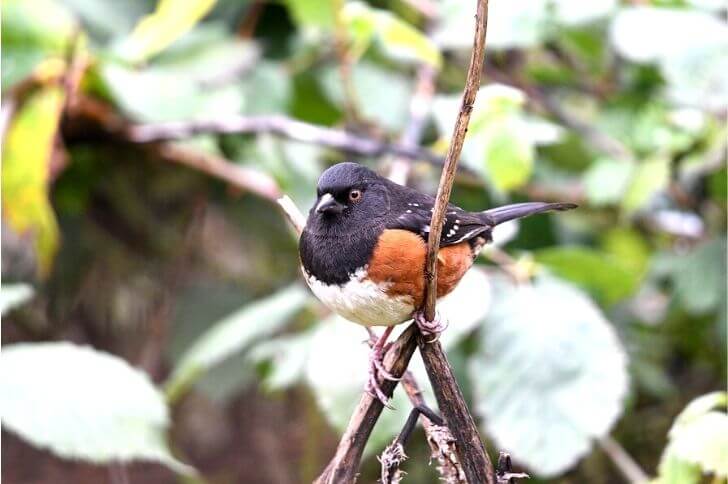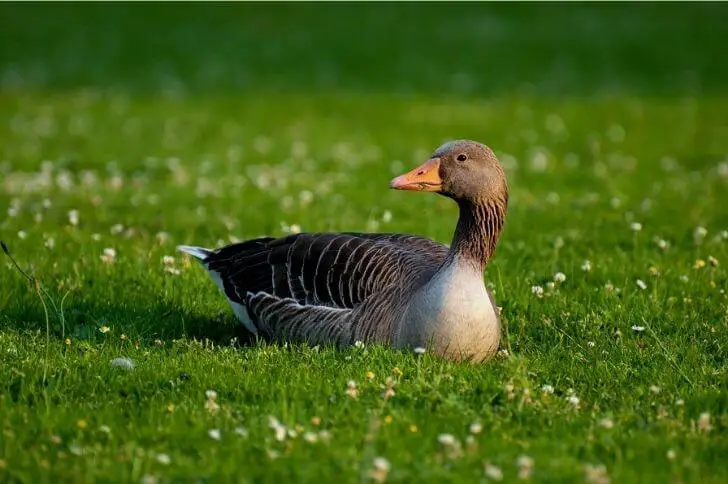There is something oddly beautiful about black birds with red beaks. These birds have an unmistakable look that can set them apart from the rest. There are many different types of red billed birds.
Below we’ll discuss common birds as well as lesser known red beak bird species. From the gorgeous black swan to dull bare-headed laughingthrush, there are plenty of birds to add on your bird watching list.
List of Black Birds with Red Beaks
1. Black swan

Size:
Large and stunning, the black swan is an unmistakable bird. How big are black swans? A mature swan can measure anywhere from 43 to 56 inches. Their wingspan is also pretty large, about 6.6 feet. How about the weight? Young birds can weigh around 8 – 14 lbs and adults up to 19.8 lbs.
Plumage:
Really hard to miss. As their name suggests they are all-black with a long s-shaped neck. Also, their wings have white patches which are noticeable when the swan is in flight. The bill and eyes are a stunning red. Juveniles, cygnets, are whitish with shorter necks.
Habitat & facts:
Black swans are large waterbirds that is native to Australia and parts of Asia. They are one of the largest members of the swan family. Black swans are usually calm and shy birds, but they can be aggressive when defending their territory or young. They eat aquatic plants and small animals, and can live for up to 25 years.
2. Red-billed chough
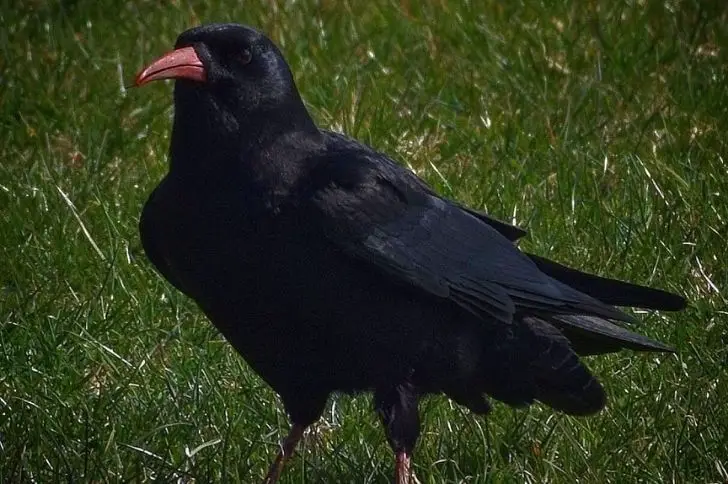
Source: mike.prior.68
Size:
Closely related to the American crow, the red-billed chough is a bird with a red beak. How big is a chough? Both sexes measure 15 – 16 inches (30 – 40 cm) with a 29 – 35 inch wingspan. Also they weigh about 10 oz.
Plumage:
Like other blackbirds, red billed choughs are all black with a red bill and feet. Their eyes are dark color. Immature birds have a dark bill.
Habitat & facts:
This species is found in open country in the mountains of southern Europe and Ireland. It has a characteristic wailing cry “chee-ow” and whistled calls. A breeding pair builds a large, untidy nest from sticks on a cliff ledge or in a crevice.
Females lay three to five eggs. The red-billed chough is monogamous and both parents care for the young. The chicks are fed mainly insects, but also take some vegetable matter. They fledge after about six weeks.
3. Red-billed partridge

Size:
How big is the red-billed partridge? Partridge birds are about 12 inches in length, making them slightly larger than red winged blackbirds.
Plumage:
Unlike other birds on this list, this is not an all black bird. To identify this red billed bird check for a streaked brown upper, black and white head and belly and of course the red beak. Note the red eye-ring.
Habitat & facts:
Red-billed partridge are birds in the pheasant family Phasianidae. They are found in much of Southeast Asia, from the Indian subcontinent east to southern China and Vietnam.
This bird is a terrestrial dweller which prefers dense cover, where it forages on the ground for seeds and insects. Their scientific name is Arborophila rubrirostris.
4. Red-billed buffalo weaver

Source: safariarchitects
Size:
In the sparse woodlands and Savannas of Africa you will find two birds that belong to the genus Bubalornis, the white-billed buffalo weaver and the red-billed buffalo weaver. Suited for this list, red-billed buffalo weavers are 8 – 9.8 inch birds that are easy to spot.
The males are slightly larger weighing up to 2.9 oz while females are 2.5 oz.
Plumage:
Red-billed buffalo weavers are sexually dimorphic, this means sexes have different color patterns. The adult male is black with white patches on the side and belly while females spot black upperparts and spotted below. Both sexes have hefty bright red bills.
Habitat & facts:
This species builds a large communal nest made of sticks, which can be used for many years. The nests are usually placed in trees or shrubs, but sometimes they are built on man-made structures. Up to 30 pairs may nest together in one colony.
Nesting season lasts from September to June. The Red-billed buffalo weaver feeds mainly on insects, but also eats fruit and seeds.
5. Red-billed curassow
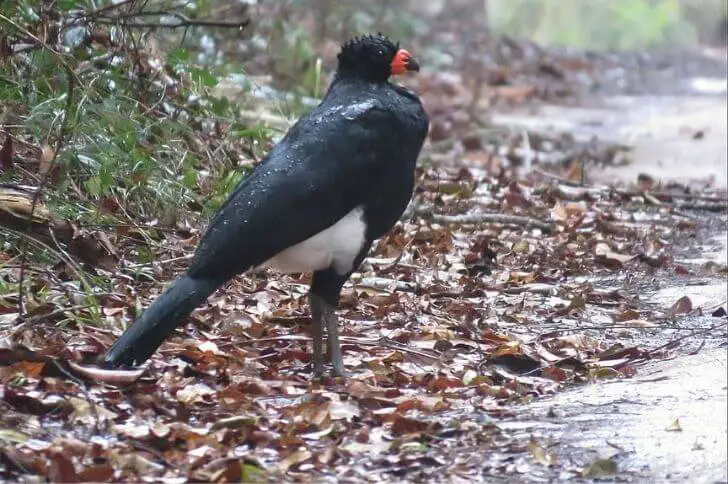
Source: epatrialbirding
Size:
With glossy black feathers and a stylish crown, red-billed curassows are large black birds with red beaks that are easy to identify. It’s typically 32 – 36 inches
Plumage:
Like the red-billed buffalo weaver above, this bird exhibits different color pattern depending on the sex. The adult female has a black head and chest, rufous belly, and chestnut-barred wings and rump.
Males are all black in color with a red black-tipped bill. Also note the red wattle that is present in males but absent in females.
Habitat & facts:
Red-billed curassows are endemic to Brazil. They are related to guans and chachalacas, and are one of the largest members of the cracidae family. This ground-bird prefers fruits.
Females lay up to 4 eggs between September and October. This bird species is considered endangered.
6. Tawny-tufted toucanet
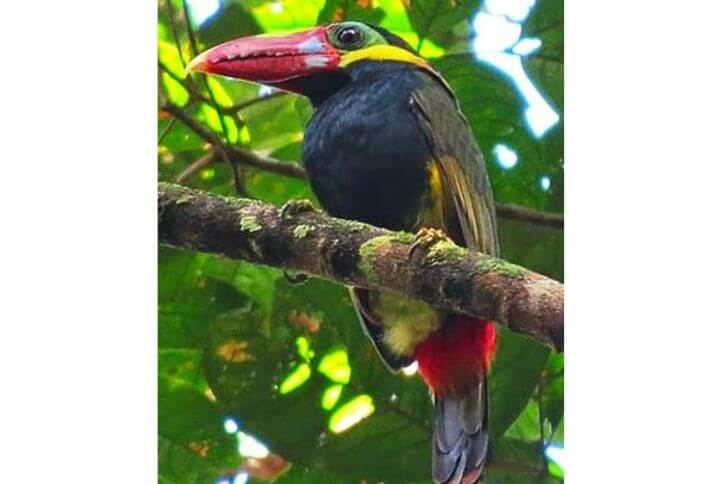
Source: Pinterest
Size:
Have you checked out a recent article on blackbirds with orange beak? We covered the toco toucan in depth. In this list we’ll look at its cousin, the tawny-tufted toucanet. They are almost the same size, about 14 inches long and weigh 5.2 – 2.9 oz.
Plumage:
When bird watching in Brazil, where they are mostly found, be on the look for a black bird with yellowish sides, large reddish bill, and a blue patch around its eyes. Females have a chestnut breast.
Habitat & facts:
Tawny-tufted toucans are one of the most colorful and charismatic birds in the Americas. They live in tropical rainforests and enjoy eating fruits. They are monogamous birds, mating for life, and typically lay two eggs per clutch. These red billed birds with black bodies are considered one of the most intelligent birds in the world.
7. Bare-headed laughingthrush
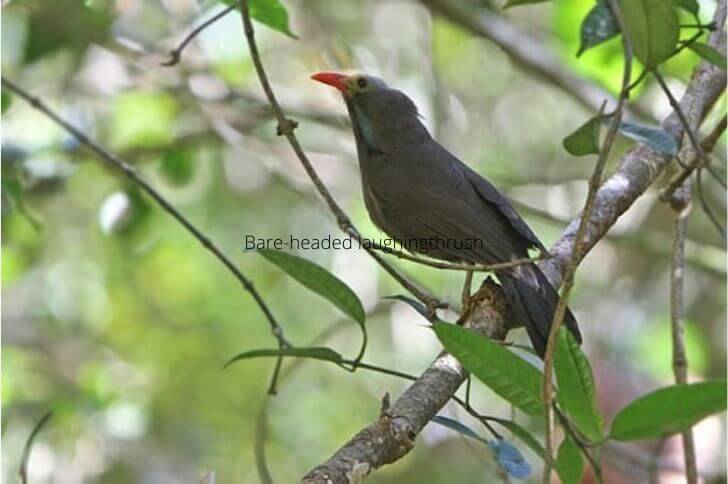
Source: ebirdography
Size:
Bare-headed laughingthrush are the same size as the blue jay; 9 – 10.2 inches or 25 – 26 cm. They are medium-sized birds and easy to see under the dense vegetation.
Plumage:
These birds with red beaks spot a featherless head, which gives it its name, and brownish-black body. Their legs are yellow while their eyes are chestnut-brown. Both sexes spot a red beak.
Habitat & facts:
The bare-headed laughingthrush is a passerine bird found in parts of Southeast Asia. It is a member of the Timaliidae family, which also includes the babblers. Bare-headed laughingthrush live in broadleaf evergreen forests, where they forage for insects and other things.
They are monogamous breeders, and build a cup-shaped nest out of twigs and vines in a tree or shrub. The female lays two to four eggs, which both parents incubate for about two weeks. The chicks fledge after another two weeks. They are non-migratory birds breed.
8. African river martin

Source: ebirdography
Size:
First described in the early 1900s by Hartlaub, the African river martin is a medium-size black bird with red beak that is about 5.5 inches in length and a wingspan of 5.6 inches.
Plumage:
How to identify a river martin? Sexes share the same color patterns. They have black bodies, a black head with bluish gloss, a red color bill, and striking red eyes. In flight you’ll notice their triangular-shaped wings.
Habitat & facts:
Where can I find the African river martin? Along the rivers of some Central Africa countries. Why is it called a river martin? These birds got their name from their preferred habitat, along river banks.
They’ll also build nests in sandbanks. Nesting season lasts from December to April. Their clutch has up to 4 white eggs. Their calls include jingling sounds that they produce when chasing each other. Their diet includes flies and winged ants.
9. Dusky broadbill
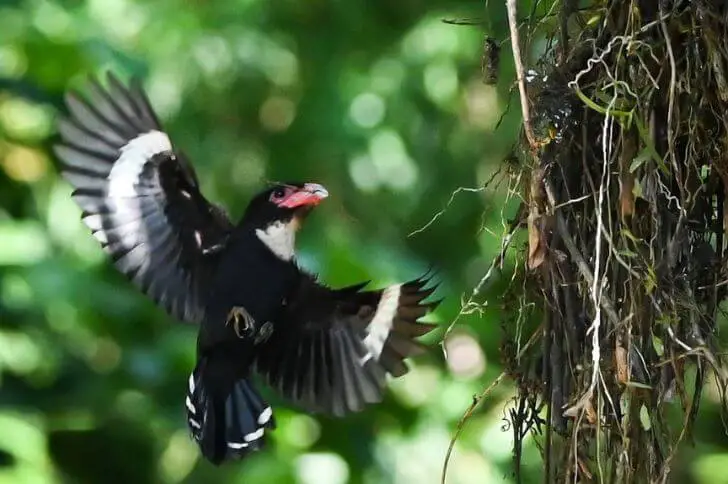
Source: siri_vite_apple
Size:
The dusky broadbill is a medium-size bird, around 8 inches, that weighs up to 0.7 oz.
Plumage:
Best way to describe dusky broadbills is odd-looking. It’s very distinctive. This bird is predominantly black with white on its wings and tail. Throat is brownish while the bill is quite broad and red. Note the bare skin around its eyes that extends to the base of the bill.
Habitat & facts:
Dusky broadbills or Corydon sumatranus are native to forests of Southeast Asia. They are members of the broadbill family. This species is usually seen singly or in pairs, and feeds on insects gleaned from foliage. The dusky broadbill is considered to be vulnerable due to habitat loss.
10. Eurasian oystercatcher

Size:
How big is the Eurasian oystercatcher? Found in parts of Europe, Eurasian oystercatchers are considered one of the largest shorebirds in those parts of the world. Mature birds can measure anywhere from 16 – 18 inches (40 – 45 cm) with a wingspan of 31 – 33 inches.
Plumage:
Not hard to miss. They have black upperparts with brownish back and white below band red legs. The 3-inch bill is reddish-yellow. Immature birds have black-tipped bills.
Habitat & facts:
Often seen in huge flocks, Eurasian oystercatchers are large waders that can be found in coastal areas throughout Europe and Asia. These birds are opportunistic predators and scavengers, and they can be seen feeding on the beach or in tidal pools.
Eurasian oystercatcher males perform elaborate courtship rituals to win over their mates. Nests are built in sheltered locations near the water’s edge, and the female lays 2-4 eggs. The chicks hatch about two weeks later and fledge when they are about six weeks old.
11. Moorhen
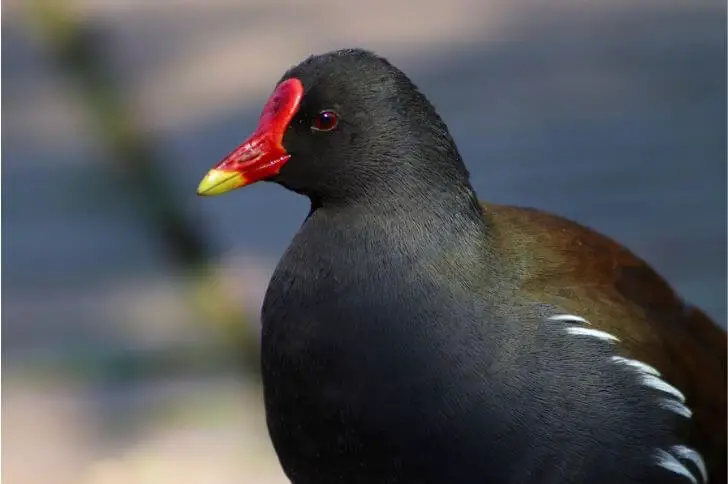
Size:
Large and easy-to-see. Moorhens are 12 – 13.8 inch (32 – 35 cm) birds with their wingspan ranging from 21 – 24.4 inches. A mature moorhen weighs about 16 oz.
Plumage:
Distinctive. Its head resembles that of a hen while the rest of the body resembles a duck’s body. Mature marshhens or moorhens are black-grey with white on the sides and bright red yellow-tipped beaks. Their legs are greenish. Juveniles are duller.
Habitat & facts:
Moorhens are waterbirds of the rail family Rallidae. They are also known as the common gallinule and waterhens.
This bird has a wide distribution in temperate and tropical regions of the world, breeding in both hemispheres. It is an omnivorous bird, eating aquatic plants, small invertebrates and fish. The moorhen is a resident breeder in Europe, North America, South America and Australia.
12. Australasian swamphen

Size:
How long are Australasian swamphens? Size ranges from 14.8-19.6 inches (38 – 50 cm). They weigh 30 – 37 oz (850 – 1050 g). This makes them some of the largest birds on this list of black birds with red beaks.
Plumage:
Though not all black, we’ve included them here because of their unique red bills. Their bodies are blue-black with reddish feet. Eyes and the strong bills are a bright red. Immature swamphens are duller with black beaks.
Habitat & facts:
Australasian swamphens also known as pukeko are large, rail-like birds that is native to the wetlands of Australasia. They live in small groups, up to 12 individuals and are known to be territorial.
What do Australasian swamphens eat? This species is omnivorous and will eat a variety of items. They typically live in wetland areas near ponds or lakes and can be seen wading through the water or grazing on nearby vegetation.
13. Black stork

Size:
With a long beak and long legs, the black stork is a beautiful bird and a great sight for any birding enthusiast. This large black and white bird with red beak is about 37 – 39 inches (95 – 100 cm) in length with wide spread wings measuring 57 – 61 inches (145 – 155 cm).
A mature male black stork can weigh up to 6.6 lbs.
Plumage:
Standing at 3 feet, it’s easy to pick a black stork from its surroundings. Mature storks have glossy black backs, head and chest while their bellies are all white. Note the red feet and eye patches. Like other birds in their family they have strong long bills that become brighter during breeding season.
Habitat & facts:
The black stork or the Ciconia nigra is a large wading bird in the stork family, Ciconiidae. It breeds in Europe, and western Asia. This species is migratory, wintering mainly in tropical Africa. It builds a large stick nest in trees near water.
14. Black bulbul

Size:
With a long tail, the black bulbul is a 9-inch bird that is endemic to Southeast Asia.
Plumage:
Their body color ranges from shinny black to a dull grey depending on their age. Their feet and bills are red. Notice the shaggy crest.
Habitat & facts:
The black bulbul is a passerine bird found in Asia. It is a member of the bulbul family, Pycnonotidae. They are a common sight in broad-leaved forests. Bulbuls are gregarious and can be quite noisy.
Their vocalizations include grating and loud cheeping calls. Black bulbuls feed on insects, fruit, and nectar. They build a cup-shaped nest of twigs in a tree or shrub and lay two or three eggs.
15. Black dwarf hornbill

Size:
Measuring about 11 inches and weighing about 4.2 oz, the black dwarf hornbill is one of the smallest members of the hornbill family.
Plumage:
This hornbill is unique with its all-black body and grayish belly. Note the pale eyebrow and dull red-tipped bill.
Habitat & facts:
Where can I find dwarf hornbills? They favor tropical forests of Africa. They are known for their unusual mating behavior, in which the male builds a nest out of mud and then gives the female a lump of mud to take back to her own nest. The female then uses the mud to decorate her own nest.
16. Black nunbird

Size:
A member of the Buccinidae family, the black nunbird is a unique bird with a bright red beak. How long is a nunbird? Most adults average 9.8 – 11 inches (25 – 29 cm). They are about 3.7 oz in weight.
Plumage:
Nunbirds are mostly black and the black nunbird is no exception. It has white-tipped wings and a stunning red bill. Note the long tail.
Habitat & facts:
Found in forests of Central America, this unique little bird is easily identifiable. Despite their innocuous appearance, black nunbirds are aggressive and territorial birds that are known to dive bomb intruders in their territory.
These pint-sized predators are accomplished hunters, preying on a variety of small prey including insects, lizards, and rodents. Black nunbirds build cup-shaped nests out of twigs high in the trees where they lay 2-4 eggs.
Hi, my name is Steve. My friend and I started the spanishbirdguides.com to share our passion with other like-minded people. So, if bird watching is your thing, you’ll love this blog. I’ll share what I’ve learnt about both local birds and those found in other parts of the world. Also, I’d love to hear your experiences.
